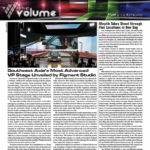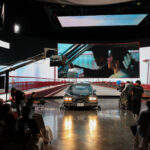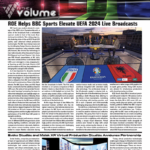INFiLED’s LED Screens Power a Musical Metaverse for Memoon Player
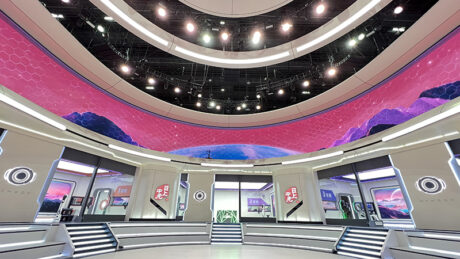
In November, the virtual reality variety show Memoon Player, produced by iQIYI officially launched in China. In this innovative show, the dedicated performance of the players—all outfitted in motion capture suits—and the immersive virtual reality scenes, made a real impression on the audience when it aired its first episode. As a part of the musical competition show, the performers donned motion capture suits and entered their avatars into a virtual landscape, where the avatars interacted, competed in games, and even performed on a virtual stage.
Memoon Player, a show that creatively brings music into the metaverse space, allows players to compete in teams, according to the rules of the show, in real and virtual interaction, and complete music-related games. During the games, through the LED displays in various scenarios, players can obtain guidance, remotely interact with online audiences, and use motion capture to generate virtual images of themselves as they compete musically.
For this virtual production project, INFiLED cooperated with Shenzhen Wanyouyingli Technology Co., Ltd. and jointly provided all the LED display equipment. The content displayed by these specialized displays was bright and colorful in keeping with the requirements of the production team.
Custom-Shaped Screens
In the spaceship-like main lobby, which was used to gather players and provide tasks, INFiLED built a massive 32m x 8m backdrop screen. The screen was customized using INFiLED’s EZ series of LED panels, with a curved surface and a shortened T shape, that was creatively designed to be futuristic looking. It featured a high-resolution pixel pitch of 2.6mm, and a brightness of 1,000nits, presenting a strong visual image that supported the content.
Just opposite the T-shaped screen, there was an INFiLED AR series curved screen with a smooth arc and a resolution of 12,672 x 1,152. This screen provided the creative content designed by the production team, and its vibrant, accurate color expression brought life to the large and unique main lobby.
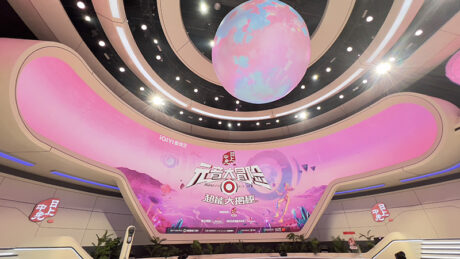
LED Screens Power Competition
To create a metaverse-style scene in the main competition venue, the production team built a small XR virtual recording platform with multiple screens. It included three INFiLED GXII series video walls, with a 3,840Hz high refresh rate and 160˚ viewing angles, making it easy for the camera crew to capture the on-wall content from different directions. The production team also deployed INFiLED’s DFII series LED product for the LED floor. With a maximum load-bearing capacity of 2,500kg/㎡ and an anti-glare surface, it was an ideal floor for carrying out the various competitions.
Since Memoon Player uses a team competition system, three cabins were set up on the recording site for each of the three teams to discuss their tactics. Each cabin was equipped with an information screen for conveying the rules of the competition to the players. The screens of the No. 1 and No. 2 cabins were made of INFiLED’s DB series, with 16-bit greyscale and a high contrast ratio of 5,000:1; while the No. 3 cabin used the INFiLED EZ series with the same specifications as the background screen of the main lobby. All of these screens provided high image clarity and well-rendered details.
Supporting Role
The theme of Memoon Player was to create a new world of music in the metaverse, so motion capture technology was widely used in the show to record the players’ body movements and generate their corresponding virtual characters; these characters were placed into imaginative rendered scenes, presenting their performances in virtual reality.
INFiLED equipped screens for all the motion capture rooms in the show. These screens used its DB series, with vibrant colors and good saturation, delivering excellent visual feedback for virtual production. Moreover, there were EZ series screens in the hallway outside the motion capture rooms, which appropriately complemented the metaverse environment created by the production team.
www.infiled.com
Fuse Technical Group Launches Two New Virtual Production Stages in Los Angeles, CA
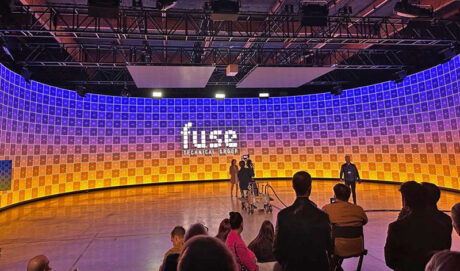
On Feb. 16, 2023, the Fuse Technical Group held a launch party for its LA Stages, two new virtual production stages located in Glendale, CA. They conducted a brief overview demo and presentation on Stage 1 and they had an In-Camera VFX Vehicle Process set up in Stage 2 for guests to see the possibilities of the spaces. The guest list was quite the cross section of Fuse’s clients; they brought in people from many of the markets they serve—music, touring, corporate, sports, streaming, broadcast, exhibits, in addition to film and television clients. They wanted to show off their two new turnkey stages with existing LED walls, lighting, and control.
Stage 1
The LED Volume on Stage 1 measures 117’ x 148’ and is 19’11” to the underside of the truss structure. The LED volume measures 44’ D from front to back; 62’ W at the center, widest point; and 51’ W at the front opening. The curved wall of the LED Volume uses ROE Visual BP2 LED panels; and ROE Visual CB5 for the ceiling and door sections. They use disguise workflow for media playback and they are Unreal ready with servers to run real-time content in Epic’s Unreal Engine. For color workflows, Fuse offers superior color depth and the ability to make fine adjustments with Pomfort Live Grade paired with their proprietary solutions. In terms of lighting, they have MA Lighting grandMA lighting control consoles as well as Unreal Engine DMX integration to mix real with virtual digital lighting. They have full support in terms of trained operators and engineers on site to support production work.
Stage 2
Stage 2 is set up for Vehicle Process production and has a stage space that measures 45’ x 62’ x 12’-8”. The vehicle entrance is 12’ x 13’ and there are lounge spaces and dressing rooms available. The LED product on Stage 2 includes ROE Visual BP2 for the movable walls and ROE Visual BP2 and CB5 for the LED ceiling. It’s designed as a flexible space for car process shots, with articulating ceiling panels and moving LED walls that allow for complete control. Again, Fuse is deploying disguise media servers for playback solutions and Unreal Engine for running real-time content. The attached control room has advanced operating stations and monitoring gear. Trained operators and engineers on site are there to fully support this stage as well.
These two new LA Stages join FUSE | Stage42, which opened in the Times Square area of New York City in October of 2022. Fuse partnered with disguise on this new studio space that comes complete with a prebuilt extended reality (xR) environment that showcases the possibilities of disguise technology. Be sure to check out what Fuse is doing in the virtual production space.
www.fuse-tg.com
Pier 59 Studios Launches Large Virtual Stage in New York City
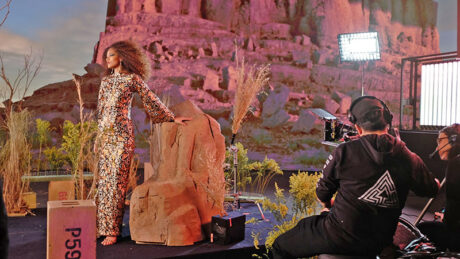
In early February, Pier 59 Studios, a film, television, and digital production facility on the west side of Manhattan, launched a large virtual production space. This innovative stage represents the latest in cinematic and television production technology. It offers brands, agencies, and content creators unlimited creative freedom to express whatever they want, in any place they can imagine, at any time of day, night, season or year. The installation, overseen by Steve Richards of Original Syndicate, is a partnership with display provider, Planar, and disguise, the media server hardware provider to design and integrate Pier59 Studios virtual production stage configuration. Some of the other technology that’s being used in this space includes RED digital cinema cameras and stYpe camera tracking systems. The plan for this space is to support In-Camera Visual Effects (ICVFX) work and to capture visual effects live and in-camera instead of during the traditional post-production process.
www.pier59studios.com
Lighting in Unreal Engine 5 Guide Available to Download
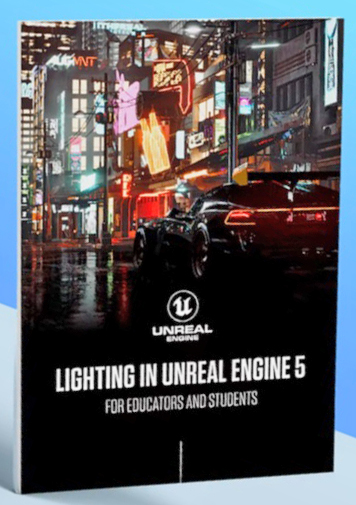
Unreal Engine has a free new guide—Lighting in Unreal Engine 5 for Educators and Students’—that covers working with lighting in Unreal Engine 5 that’s aimed at educators and students. As we all should embrace the mantra of ‘always be learning,’ this new guide provides some tips and tricks on improving your lighting when working with Unreal Engine 5, Carbon for Unreal, or other virtual production workflows that are based on Unreal Engine. As Unreal notes, lighting is how we add drama, make designs look realistic, and keep people immersed in virtual worlds. That is why Unreal Engine 5 shipped with some of our most innovative lighting features yet. Years of research have resulted in Lumen, Virtual Shadow Maps, and updates to GPU Lightmass. This trio of tricks have what users need to create stunning art in the years to come. But where to start? To help, UE has released its latest guide: Lighting in Unreal Engine 5 for Educators and Students.
In the guide, readers will find the type of overview worthy of anyone looking to wrap their head around the what, whys, and hows of this generational shift in games-lighting technology. While this isn’t a technical walkthrough, it should provide an easy framework for getting started or building out effective course materials. The guide is an opportunity to learn more about what these new features can do; whether software or hardware-based ray-tracing is best for Lumen; Optimization and troubleshooting; current limitations; pros and cons of using baked vs. dynamic GI lighting; tips for teachers; documentation resources; and a lot more. If you are looking to demystify UE5 lighting check out UE’s free Lighting in Unreal Engine 5 for Educators and Students guide. You can download it at: https://cdn2.unrealengine.com/lighting-for-educators-and-students-20mb-6b793664ebe8.pdf
